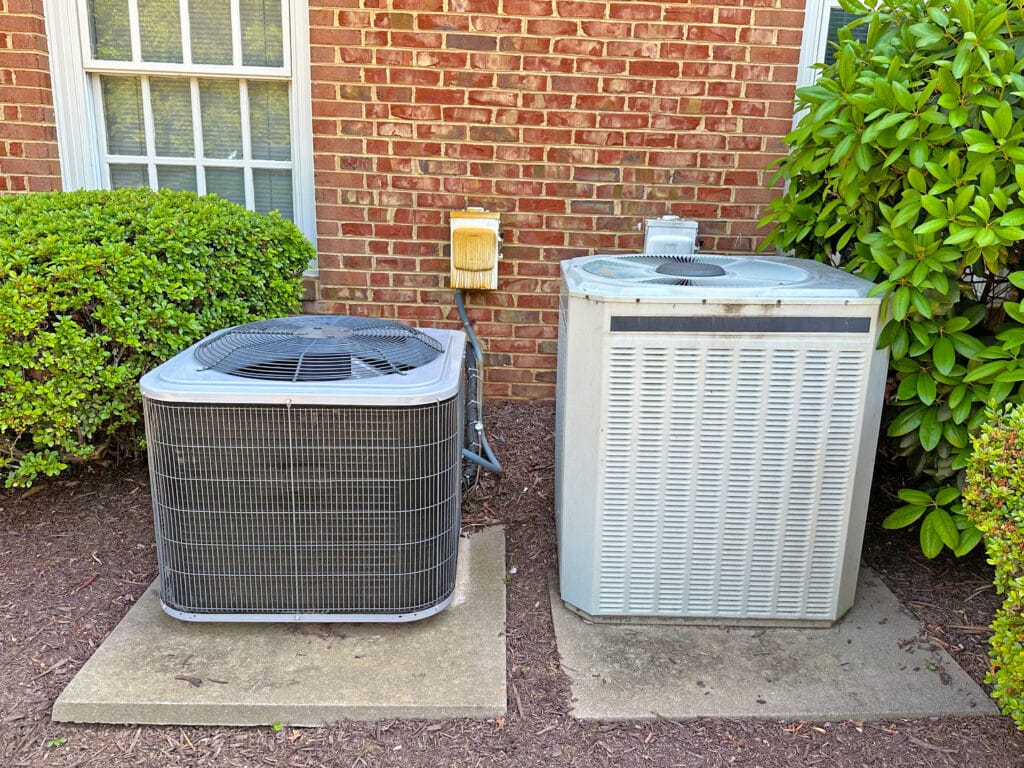Components Of HVAC Systems Residential: A Complete Guide

Have you ever wondered what keeps your home so comfortably warm in the winter and refreshingly cool during the summer months?
It’s all thanks to your HVAC system, a crucial component of modern residential living.
Understanding the components of HVAC systems residential systems can help you maintain it better, ensuring your home remains a haven of comfort year-round.
In this article, we’ll dive deep into the components of HVAC system residential setups. We’ll explore each component’s role, how they work together to maintain your home’s climate, and tips for keeping your system running efficiently.
Whether you’re a new homeowner or looking to brush up on your HVAC knowledge, this guide has everything you need to know.
Also read: Geothermal vs Heat Pump Systems: A Smart Homeowner’s Guide

What are the Components of an HVAC Systems Residential?
Understanding the components of HVAC systems residential setups is essential for any homeowner looking to maintain a comfortable and healthy living environment. These systems are complex, integrating various elements to heat, cool, and ventilate your home efficiently.
Let’s delve deeper into each component and its significance.
Heating Unit: The heating component, often a furnace or heat pump, is responsible for generating warm air during colder months. Furnaces burn fuel (such as gas, oil, or electricity) to produce heat, while heat pumps transfer heat from the outside air into your home, serving a dual function by cooling your home in the summer.
Ventilation System: This system ensures that your indoor air remains fresh and free of pollutants. It works by exchanging indoor air with outdoor air, removing contaminants, smoke, odors, and moisture, thus preventing mold growth and maintaining optimal air quality.
Air Conditioning Unit: The air conditioning unit is crucial for cooling your home by removing heat and humidity from the indoor air. It works in conjunction with the ventilation system to circulate cooled air throughout your home, ensuring comfort during warmer seasons.
Thermostat: Serving as the control center, the thermostat allows you to set and adjust the temperature within your home according to your preferences.
Modern thermostats offer programmable settings and smart technology, enabling energy savings by adjusting temperatures based on your schedule and preferences.
Ductwork: Ductwork is the network of tunnels that distributes the heated or cooled air from your HVAC system to various parts of your home.
Properly designed and sealed ductwork is crucial for the efficiency and effectiveness of your HVAC system, ensuring even distribution of air and preventing energy losses.
Incorporating these components of HVAC systems residential, a residential HVAC system works seamlessly to maintain the desired climate within your home, ensuring comfort throughout the year.
Understanding these components of HVAC system residential and their functions can help homeowners make informed decisions about maintenance, upgrades, and energy efficiency, contributing to a comfortable, safe, and healthy living environment.
Heating Component: Furnace and Heat Pump Dynamics
The heating component is a pivotal part of the components of HVAC systems residential setup, ensuring your home remains warm and comfortable during the colder months.
This section is divided into two primary devices used for heating: furnaces and heat pumps, each with its unique method of providing warmth.
Furnace: The Traditional Heating Powerhouse
A furnace is a traditional heating system found in many homes, known for its efficiency and reliability. It operates by burning fuel—typically natural gas, oil, or propane—to generate heat.
The heat produced is then distributed throughout the home via the ductwork. Furnaces are praised for their ability to quickly heat spaces, making them ideal for regions that experience harsh winters. They are also known for their longevity, with many models capable of operating effectively for 15 to 20 years with proper maintenance.
Heat Pump: Efficient Heating and Cooling
Heat pumps are versatile units that provide both heating and cooling functions, making them a cost-effective solution for year-round climate control.
Unlike furnaces that generate heat through fuel combustion, heat pumps work by transferring heat from the outside air into your home during the winter. In the summer months, this process is reversed to cool your home by removing indoor heat.
Heat pumps are particularly efficient in mild climates where the temperature differences are not extreme. Their efficiency comes from their ability to transfer heat rather than generate it, which can lead to significant energy savings.
Understanding the differences between furnaces and heat pumps, and how they contribute to the heating component of an HVAC system, allows homeowners to make informed decisions based on their specific needs, climate, and energy consumption goals.
Whether opting for the traditional power of a furnace or the versatile efficiency of a heat pump, the right choice ensures optimal warmth and comfort in any residential setting.
Ventilation Component: Ensuring Healthy Indoor Air Quality
The ventilation component is a critical aspect of the components of HVAC systems residential setup, playing a vital role in maintaining the health and comfort of your home’s indoor environment.
Effective ventilation is essential for not only providing a continuous supply of fresh outdoor air but also for removing indoor pollutants, thus ensuring the air you breathe is clean and safe.
The Importance of Fresh Air Exchange
One of the primary functions of the ventilation system is to facilitate the exchange of indoor air with fresh outdoor air.
This process helps to dilute and remove pollutants from indoor spaces, which can include everything from volatile organic compounds (VOCs) emitted by paints and furnishings to allergens and pathogens.
Regularly introducing fresh air into the home is crucial for preventing the buildup of these contaminants, which can adversely affect health and indoor air quality.
Removing Contaminants and Regulating Humidity
In addition to exchanging air, the ventilation component works to remove contaminants directly from the home. This includes kitchen fumes, bathroom humidity, and other pollutants that can contribute to mold growth and poor air quality.
By effectively removing these contaminants, the ventilation system helps to protect the structural integrity of the home and the health of its occupants.
Moreover, proper ventilation plays a significant role in regulating indoor moisture levels. Excess humidity can lead to condensation, mold growth, and an overall decrease in indoor air quality. By controlling moisture, the ventilation system helps to maintain a comfortable and healthy living environment.
Understanding the critical role of the ventilation component in maintaining indoor air quality underscores the importance of a well-designed and properly maintained HVAC system.
By ensuring efficient air exchange, contaminant removal, and moisture regulation, the ventilation system significantly contributes to the overall health, comfort, and well-being of residential spaces.
Also read: Quick Fix: Emergency Heating and AC Repair Solutions

Air Conditioning Component: The Heart of Home Comfort
The air conditioning component is a cornerstone of the components of HVAC systems residential setup, pivotal in ensuring your home remains a sanctuary of cool, refreshing air during the warmer months.
This system not only cools your home but also plays a crucial role in removing humidity, thus enhancing the overall comfort and livability of your indoor spaces.
Cooling Mechanism: How It Works
The air conditioning unit operates on the principle of heat exchange.
Refrigerant, the substance within the system, absorbs heat from the indoor air and transfers it outside, leaving the air inside your home cooler.
This process is facilitated by the components of HVAC systems residential, the evaporator coil, which is located inside the house, and the condenser coil, situated outside. Together, they work in tandem to extract heat and humidity from the indoor air efficiently.
Humidity Control: Beyond Just Cooling
While cooling is the primary function of the air conditioning unit, its ability to control humidity is equally important. High humidity levels can make indoor temperatures feel warmer than they are, contributing to a sticky, uncomfortable environment.
By removing excess moisture from the air, the air conditioning unit helps maintain a comfortable humidity level, enhancing the overall comfort of your home.
Integration with Ventilation System
The effectiveness of the air conditioning unit is significantly enhanced by its integration with the home’s ventilation system. This collaboration ensures that cooled and dehumidified air is evenly distributed throughout the house.
Proper ventilation also aids in the removal of stale air and pollutants, working in conjunction with the air conditioning unit to improve indoor air quality and comfort.
Understanding the air conditioning component’s operation, its role in humidity control, and its integration with the ventilation system highlights its importance in maintaining a comfortable, healthy, and enjoyable home environment.
As technology advances, opting for energy-efficient models can further enhance indoor comfort while minimizing energy consumption, aligning with modern homeowners’ desires for sustainable living solutions.
Air Handler: The Circulatory System of Your HVAC
The air handler (one of the components of HVAC systems residential) serves as the heart that pumps air throughout your home.
This crucial piece of equipment works in tandem with the heating and cooling elements to ensure that air is efficiently distributed to every corner of your living space.
Understanding the role and functionality of the air handler can significantly enhance your home’s comfort levels and the overall efficiency of your HVAC system.
Components of the Air Handler
The air handler comprises several key components of HVAC systems residential: each playing a vital role in air circulation:
Blower Motor
This is the driving force that propels air through the ductwork. Depending on the model, blower motors can have variable speeds to adjust airflow based on the system’s needs, contributing to the system’s overall efficiency and comfort levels.
Coils
In conjunction with the heating and cooling elements, the coils in the air handler either heat or cool the air as it passes through. The efficiency of these coils directly impacts the effectiveness of your components of HVAC systems residential in temperature regulation.
Air Filters
Positioned within the air handler, these filters trap dust, pollen, and other airborne particles, ensuring that the air distributed throughout your home is clean.
Regular maintenance of these filters is crucial for maintaining air quality and the efficient operation of your HVAC system.
The Importance of the Air Handler in HVAC Efficiency
The efficiency of your components of HVAC systems residential heavily relies on the proper functioning of the air handler.
A well-maintained air handler ensures optimal airflow, which is essential for maintaining desired temperature levels throughout your home. It also plays a critical role in air filtration, improving indoor air quality by removing contaminants from the air before they circulate through your living spaces.
Maintaining Your Air Handler
Regular maintenance of the air handler is essential for the longevity and efficiency of your HVAC system.
This includes periodic checks and cleaning of the blower motor, and coils, and replacing air filters regularly. Ensuring that these components of HVAC systems residential are in good working condition can prevent common HVAC issues, reduce energy consumption, and extend the life of your system.
The air handler is more than just a component; it’s the lifeline of your components of HVAC systems residential, ensuring that heated or cooled air is effectively circulated throughout your home.
By understanding its role and maintaining its residential HVAC system components, you can enjoy a more comfortable, efficient, and healthy living environment.
Regular maintenance and awareness of the air handler’s function within the components of HVAC systems residential can lead to significant improvements in system performance and energy savings.
Thermostat: The Brain Behind Home Climate Control
The thermostat stands as the central command of the components of HVAC systems residential setup, playing a pivotal role in regulating the indoor climate to match your comfort preferences.
This device not only allows homeowners to set their desired temperature but also acts as a communication hub between you and your components of HVAC systems residential operate harmoniously to maintain the ideal home environment.
Temperature Regulation: Setting the Comfort Standard
At its core, the thermostat’s primary function is to maintain the desired temperature within your home.
By sensing the current indoor temperature and comparing it to your set preferences, the thermostat makes real-time adjustments to the components of HVAC systems residential operation. This ensures that whether it’s the heat of summer or the chill of winter, your living spaces remain consistently comfortable.
Programmable and Smart Thermostats: Elevating Efficiency
Advancements in thermostat technology have led to the development of programmable and smart thermostats, which offer enhanced control over your home’s heating and cooling.
Programmable thermostats allow you to set schedules for different times of the day or week, automatically adjusting the temperature based on your routine.
This means you can set your system to lower the heat when you’re away at work or asleep, and warm up the house just before you return or wake up, optimizing comfort and energy efficiency.
Smart thermostats take this a step further by learning from your habits and making energy-efficient adjustments automatically.
Many models can be controlled remotely via smartphone apps, providing the convenience of adjusting your home’s temperature from anywhere. Additionally, smart thermostats can provide valuable insights into your energy consumption, helping you make informed decisions to further reduce energy costs.
Understanding the thermostat’s capabilities and the benefits of programmable and smart models can significantly impact your home’s climate control and energy consumption.
By effectively managing the components of HVAC systems residential‘s operation, the thermostat ensures your living environment is always tailored to your comfort preferences while optimizing energy use.
Ductwork: The Circulatory System of Home Comfort
Ductwork is an integral component of the components of HVAC systems residential setup, acting as the circulatory system that distributes conditioned air throughout your home.
This network of tunnels ensures that every room reaches your desired temperature, providing a uniform climate across different spaces.
Understanding the structure and function of ductwork can significantly enhance the efficiency and effectiveness of your HVAC system.
Design and Distribution: The Pathways of Comfort
The design of the ductwork system is crucial for efficient air distribution. Properly sized and strategically placed ducts ensure that heated or cooled air is delivered to every corner of your home without unnecessary loss of energy.
This involves a careful balance between the supply ducts, which carry air from the HVAC unit to the home’s interior, and the return ducts, which bring air back to the unit for reconditioning.
An optimally designed ductwork system minimizes energy consumption while maximizing comfort.
Sealing and Insulation: Guarding Against Loss
One of the key aspects of maintaining an efficient ductwork system is ensuring that it is properly sealed and insulated.
Leaks in the ductwork can lead to significant energy losses, as conditioned air escapes into unoccupied spaces such as attics or crawl spaces instead of reaching its intended destinations.
Sealing these leaks and insulating ducts, especially those passing through unconditioned spaces, can dramatically reduce energy waste and lower utility bills.
Understanding the complexities of ductwork design, along with the importance of sealing and insulation, is crucial for homeowners looking to optimize their HVAC system’s performance.
Properly maintained ductwork not only ensures efficient distribution of conditioned air but also contributes to the overall energy efficiency of your home, making it a key factor in achieving year-round comfort and sustainability.
Here’s everything else you need to know about maintaining your HVAC system and ensuring it operates at peak efficiency.
How to Enhance Your Home’s HVAC Efficiency
Improving the efficiency of your components of HVAC systems residential setup is crucial for reducing energy consumption, lowering utility bills, and ensuring your home remains comfortable throughout the year. Here, we’ll explore several strategies to enhance your system’s performance.
Optimizing Airflow for Maximum Efficiency
Ensuring optimal airflow within your HVAC system is key to maintaining energy efficiency and prolonging the life of your system.
Blocked or restricted airflow can cause your system to work harder, leading to increased wear and tear and higher energy costs.
Regularly cleaning or replacing air filters, ensuring vents are unobstructed by furniture or curtains, and having your ductwork professionally cleaned can significantly improve airflow, making your HVAC system more efficient.
Leveraging Zoning Systems for Customized Comfort
Zoning systems allow you to divide your home into different areas or “zones,” each controlled independently by its own thermostat.
This means you can customize the heating and cooling settings for each zone based on its occupancy or specific temperature needs, reducing energy waste in unoccupied spaces.
Installing a zoning system can enhance the overall efficiency of your components of HVAC systems residential setup by targeting only the areas that need temperature regulation, leading to significant energy savings.
Investing in Energy-Efficient HVAC Components
When it’s time to replace or upgrade parts of your HVAC system, choosing energy-efficient components of HVAC systems residential can make a substantial difference in your system’s performance and your home’s energy consumption.
Look for high-efficiency models of furnaces, air conditioners, and heat pumps that have a high SEER (Seasonal Energy Efficiency Ratio) rating for cooling and a high AFUE (Annual Fuel Utilization Efficiency) rating for heating.
These models use advanced technology to reduce energy use while maintaining optimal comfort levels in your home.
Regular Professional Evaluations
Having a professional HVAC technician evaluate your system can uncover opportunities to enhance its efficiency. These evaluations can include checking for leaks in the ductwork, assessing the system’s overall performance, and recommending upgrades or adjustments to improve efficiency.
Regular assessments ensure that components of HVAC systemsresidential setup are functioning optimally, providing you with the best possible performance and energy savings.
By focusing on these areas, homeowners can significantly enhance the efficiency of their HVAC systems, leading to improved comfort, lower energy bills, and a reduced environmental impact.
Each of these strategies contributes to a more sustainable and cost-effective approach to home heating and cooling, aligning with the needs and values of today’s homeowners.
How to Future-Proof Your Components for HVAC System Residential
Incorporating future-forward strategies into the components of HVAC systems residential setup is essential for ensuring your home’s heating, ventilation, and air conditioning system remains efficient, sustainable, and capable of meeting your family’s needs for years to come.
Embracing Smart HVAC Technologies
Smart HVAC technologies have revolutionized how we control and optimize our home environments.
From smart thermostats that learn your schedule and adjust temperatures accordingly to HVAC systems that can be monitored and controlled via smartphone apps, these technologies offer unparalleled convenience and efficiency. Implementing these solutions can lead to significant energy savings and a more comfortable home environment.
Sustainable Heating and Cooling Solutions
Sustainable heating and cooling options are becoming increasingly important as homeowners seek to reduce their carbon footprint and energy consumption.
Exploring alternatives such as geothermal heat pumps, solar-powered HVAC systems, and other renewable energy sources can drastically decrease reliance on fossil fuels and promote a greener, more sustainable home.
Regular System Upgrades and Evaluations
System upgrades and evaluations are critical for keeping your HVAC system at peak performance.
As technology advances, so do the efficiency and capabilities of components of HVAC systems residential. Regularly assessing your system and considering upgrades, especially to energy-efficient models, can future-proof your home, ensuring it stays comfortable, efficient, and environmentally friendly.
By focusing on smart technologies, sustainable solutions, and regular upgrades, homeowners can effectively future-proof their HVAC systems.
These strategies not only enhance the current performance and efficiency of your components of HVAC systems residential setup but also ensure that your home remains adaptable to future advancements in HVAC technology and environmental sustainability standards.
How To Maximize Indoor Air Quality With Your Components Of HVAC Systems Residential
Ensuring the air within your home is clean and free from pollutants is a crucial function of your HVAC system.
This section explores advanced strategies and components of HVAC system residential designed to enhance indoor air quality, contributing to a healthier living environment.
Advanced Filtration Systems
Incorporating High-Efficiency Air Filters
Upgrading to high-efficiency particulate air (HEPA) filters or other advanced filtration systems can significantly improve the air quality in your home.
These filters are capable of capturing a higher percentage of airborne particles, including pollen, pet dander, dust mites, and other allergens, compared to standard filters.
Discussing the benefits and maintenance requirements of these advanced filters can provide homeowners with actionable insights to enhance their indoor air quality.
Humidity Control Solutions
Balancing Indoor Humidity Levels:
Maintaining optimal humidity levels is essential for both comfort and health.
Too much humidity can encourage mold growth and increase allergens, while too little can lead to dry air that irritates the skin and respiratory system.
Integrating humidity control solutions, such as whole-home dehumidifiers or humidifiers, into your HVAC system can help stabilize indoor humidity levels, ensuring a more comfortable and healthier home environment.
Ventilation Enhancements
Improving Air Exchange with Enhanced Ventilation:
Proper ventilation is key to maintaining high indoor air quality. Energy recovery ventilators (ERVs) and heat recovery ventilators (HRVs) are advanced options that facilitate better air exchange without compromising the energy efficiency of your home.
These systems can remove stale indoor air, bring in fresh outdoor air, and recover energy from the air exchange process, making them an excellent addition to any components of HVAC systems residential setup focused on maximizing indoor air quality.
By focusing on advanced filtration, humidity control, and enhanced ventilation, homeowners can significantly improve the air quality within their homes.
Each of these strategies not only contributes to a healthier living environment but also enhances the overall performance and efficiency of residential HVAC systems.
Energy Conservation Techniques for Residential HVAC Systems
In the quest for a more energy-efficient home, understanding and implementing energy conservation techniques within your components of HVAC systems residential setup is essential. This approach not only reduces your carbon footprint but also leads to significant savings on utility bills.
Here, we explore practical strategies for achieving greater energy efficiency in your home’s heating, cooling, and ventilation systems.
Strategic Thermostat Management
Optimizing Temperature Settings
One of the simplest yet most effective strategies for conserving energy is the strategic management of your thermostat settings.
Utilizing programmable or smart thermostats can automate temperature adjustments based on your daily schedule and seasonal needs, ensuring that you’re not overusing your HVAC system when it’s not necessary.
Setting your thermostat to a slightly lower temperature in winter and a higher temperature in summer can result in substantial energy savings without sacrificing comfort.
Enhancing System Efficiency with Regular Maintenance
Preventive Maintenance for Peak Performance:
Regular maintenance is crucial for keeping your HVAC system running efficiently. This includes routine tasks such as replacing air filters, cleaning ducts, and scheduling annual inspections with a qualified technician.
These actions help ensure that your system is not working harder than it needs to, thereby conserving energy.
A well-maintained HVAC system not only operates more efficiently but also has a longer lifespan, providing better value for your investment.
Upgrading to High-Efficiency HVAC Components
Investing in Modern, Energy-Efficient Technology:
As HVAC technology advances, newer models are designed with energy conservation in mind. Upgrading to high-efficiency components of HVAC systems residential can make a significant difference in your home’s energy consumption.
Look for products with the ENERGY STAR label, indicating they meet or exceed federal standards for energy efficiency.
While the upfront cost of these upgrades can be higher, the long-term savings on energy bills and the positive impact on the environment make it a worthwhile investment.
Implementing these energy conservation techniques within your components of HVAC system residential setup is a proactive step towards a more sustainable and cost-effective home environment.
By optimizing thermostat settings, ensuring regular maintenance, and investing in high-efficiency components of HVAC systems residential, homeowners can significantly reduce their energy usage while maintaining a comfortable and healthy living space.
Top 5 Tested and Proven Tips for Your Optimizing HVAC System Components
Maintaining and optimizing the components of HVAC systems residential setup is crucial for ensuring your home remains comfortable, your air quality high, and your energy bills low.
Here are the top five strategies to keep your HVAC system at peak performance.
Regular Maintenance: The Foundation of Efficiency
Scheduled Professional Check-ups
Annual inspections by a professional HVAC technician are essential. These check-ups can identify and rectify minor issues before they escalate into major problems, ensuring your system runs smoothly and efficiently.
Regular maintenance includes cleaning components of HVAC systems residential, checking system functions, and preventing wear and tear, which can extend the lifespan of your HVAC system.
Upgrade Your Thermostat: Smart Control for Smart Savings
Upgrading to a programmable or smart thermostat is a game-changer for energy consumption and utility bills. These devices allow you to set temperature schedules that align with your lifestyle, ensuring you’re not heating or cooling an empty house.
Smart thermostats go a step further by learning your habits and adjusting settings automatically for optimal comfort and efficiency.
Seal and Insulate Ductwork: Enhancing Airflow and Efficiency
Ductwork leaks and poor insulation are significant sources of energy waste in many homes. Sealing leaks and insulating ducts, especially those in unconditioned spaces like attics or basements, can dramatically improve your HVAC system’s efficiency.
This not only reduces energy consumption but also ensures consistent temperatures throughout your home, enhancing overall comfort.
Change Filters Regularly: A Simple Step with Big Impact
Regularly changing your HVAC filters (every 90 days or as recommended) is one of the simplest yet most effective ways to improve your system’s efficiency and the air quality in your home.
Clean filters ensure optimal airflow and reduce strain on your system, preventing unnecessary energy use and wear on components of HVAC systems residential.
Consider System Upgrades: Investing in Future Comfort
If your HVAC system is outdated, investing in a newer, more energy-efficient model can lead to significant savings and improved comfort in the long run.
Modern components of HVAC system residential are designed with efficiency in mind, offering superior climate control, reduced energy consumption, and lower utility bills. Plus, many come with advanced features like zoning capabilities and integrated smart technology for enhanced control and convenience.
Adopting these five strategies can significantly enhance the performance and efficiency of your HVAC system, ensuring it provides reliable comfort and air quality for years to come while keeping energy consumption and costs in check.
One Hour Air Conditioning & Heating of Phoenix, AZ: Your HVAC System Experts
One Hour Air Conditioning & Heating of Phoenix, AZ, stands out as a premier provider of HVAC services, catering to all components of HVAC system residential needs.
Their comprehensive range of services ensures that homes in Phoenix, Scottsdale, Paradise Valley, Chandler, Mesa, and Tempe enjoy optimal comfort and efficiency throughout the year.
Expert Installation Services
Tailored Solutions for Every Home
One Hour Air Conditioning & Heating specializes in the expert installation of HVAC systems. Understanding that every home has unique needs, they offer customized solutions designed to provide maximum comfort and efficiency.
Whether you’re installing a new system or replacing an old one, their team ensures a seamless integration of the latest HVAC technologies into your home.
Maintenance and Repair Services
Preventive Care and Prompt Repairs
Regular maintenance is crucial for the longevity and efficiency of your HVAC system. One Hour Air Conditioning & Heating offers comprehensive maintenance plans that cover all aspects of your system, ensuring it operates smoothly and efficiently year-round.
Their skilled technicians are also on call for prompt repair services, equipped to handle any issue, from minor fixes to major breakdowns, ensuring minimal downtime and discomfort.
Serving the Greater Phoenix Area
Local Expertise, Wide Coverage
With a deep understanding of the local climate and specific needs of the Phoenix area, One Hour Air Conditioning & Heating of Phoenix is uniquely positioned to provide services that are not only effective but also tailored to the challenges of the desert environment.
Their coverage extends to key cities, including Scottsdale, Paradise Valley, Chandler, Mesa, and Tempe, making professional HVAC services accessible to a broad range of residents.

Why Choose One Hour Air Conditioning & Heating?
Reliability, Efficiency, and Customer Satisfaction
Choosing One Hour Air Conditioning & Heating means opting for a service provider that values reliability, efficiency, and customer satisfaction above all.
Their commitment to timely service, coupled with their expertise in handling components of HVAC system residential setups, ensures that your HVAC system is in capable hands. Moreover, their use of the latest technologies and techniques means you’re getting the most energy-efficient solutions available, tailored to your specific needs and preferences.
Conclusion: Maximizing Comfort With Components Of HVAC Systems Residential
Grasping the intricacies of components of HVAC system residential setups is fundamental for any homeowner aiming to sustain a living space that is not only comfortable but also energy-efficient.
The synergy between regular maintenance, strategic upgrades, and seeking professional guidance forms the cornerstone of a well-functioning HVAC system. This holistic approach ensures that your system not only meets your current comfort needs but is also primed for optimal performance in the long run.
Investing in smart thermostat technology, ensuring your ductwork is properly sealed and insulated, and opting for energy-efficient components of HVAC system residential models are smart upgrades that can significantly impact your system’s efficiency and durability.
These enhancements, coupled with routine professional check-ups, can prevent unexpected breakdowns, reduce energy consumption, and extend the lifespan of your HVAC system.
Professional components of HVAC system residential services play a pivotal role in maintaining the health of your system. Experts like One Hour Air Conditioning & Heating of Phoenix, AZ, offer invaluable advice and tailored solutions that address the unique needs of your home. Their expertise can guide you through the maze of options available, ensuring that your investments are both cost-effective and beneficial to the overall climate control of your home.
As we wrap up, it’s clear that understanding and maintaining the components of HVAC systems residential setup is key to achieving a harmonious balance between comfort, efficiency, and sustainability.
What questions do you have about maintaining your components of HVAC systems residential for optimal performance?
Engaging with professionals and staying informed about your system’s needs can empower you to make decisions that enhance your living environment for years to come.

FAQs About Components Of HVAC Systems Residential
-
What are the main components of an HVAC system in a residential setting?
The main components include the heating unit, ventilation system, air conditioning unit, thermostat, and ductwork.
-
How often should I have my HVAC systems serviced?
It’s recommended to have your HVAC system serviced annually to ensure it’s running efficiently.
-
Can upgrading my thermostat really save money?
Yes, upgrading to a programmable or smart thermostat can help reduce energy consumption and lower utility bills.
-
Why is it important to change my HVAC filters regularly?
Changing your HVAC filters every 90 days can improve air quality and the efficiency of your system.
-
What should I do if my HVAC system isn’t heating or cooling my home effectively?
If your HVAC system isn’t performing well, it’s best to contact a professional for an inspection and potential repairs.





